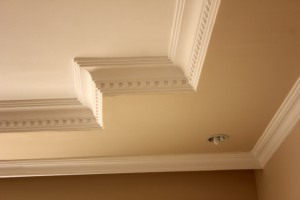
Interior trim adds a great deal of depth and detail to a room.
Interior trim has become so ubiquitous that many people don’t even give it much thought anymore. Despite this, trim design elements add a ton of depth, detail, and richness to a room. Here are a look at how some of the most common trim and molding elements are used to enliven a room.
Base – The base, or baseboard, is used where the wall and floor come together to conceal gaps between the floor and the wall. It also provides protection to the wall finish from swinging feet, jostled furniture and other hazards. These days, most bases are made from a single piece to create a cleaner and more contemporary aesthetic.
Chair Rail – The chair rail protects the wall finish from furniture being placed against the wall. Chair rails are typically installed about 36 inches off the floor, but can really be installed at just about any height. How the chair rail splits the walls into horizontal layers is a key design consideration.
Wainscot – Sometimes the space between the chair rail and the baseboard is paneled. This is called wainscot, and it comes in a variety of options–wood panels, beadboard, raised panels. Sometimes the wainscoting will match the wood trim and other times it will provide more deeper contrast.
Window Casings – Window casings feature a separate side, top and bottom piece to allow for rich details to be composed in the trim. Window cases with distinct pieces can feature a nice, deep sill, for example.
Door Casings – Unlike window casings, door casings feature no bottom stool or apron (for obvious reasons). Often times the door casing will match the family of trim profiles used for the window casing, but sometimes scale will be changed to distinguish the two in more sophisticated designs.
Picture Rail – Originally this particular piece of trim was used to hang pictures on, but the advent of inexpensive picture hooks has made this feature obsolete. Now picture rails are mostly used as a decorative element to divide the wall into additional layers.
Plate Rail – This trim provides an area for you to display a collection of objects. The depth can vary from very shallow to quite deep depending on your needs. Deeper rails will typically need to be placed higher on the wall so that they are out of the way. Trim lines at the top of windows and below the ceiling can also serve as a powerful design tool.
Crown Molding – The crown molding is at the top of the wall where wall and ceiling come together. Crown moldings are particularly useful for softening the transition between wall and ceiling, and vertical and horizontal planes. This makes for a more elegant design.
Get In Touch With Mahogany Inc. To Learn More About Custom Woodwork Today
Mahogany, Inc. is a general contractor specializing in quality construction for projects across a wide range of industries. Located in southwest Baltimore, we employ 100 persons, and are one of the largest minority-owned businesses in the state of Maryland. If you are looking for custom millwork or other amazing wooden installations, then check out our website! Make sure to check back with our blog every week and find us on social media for important updates!
